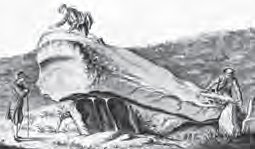 |

|
|||

KILTIERNAN County DublinThis magnificent portal tomb is one of several megaliths in the Dublin area illustrated by Gabriel Beranger, an antiquarian artist working in Ireland in the latter half of the eighteenth century. Beranger clearly recognised the importance of recording these ancient remains which were often endangered, and which in some instances have since disappeared. Fortunately this great dolmen has survived and remains much as he saw it over two centuries ago.
Beranger often introduced human figures into his watercolours to convey a sense of scale, and here he shows two surveyors at work, dwarfed by the huge capstone they are engaged in measuring. The person supervising this activity is in all probability Beranger, who sometimes included himself in his compositions.
The picture may have been the inspiration for Borlase’s description of this monument as ‘a sphinx-like monster, advancing out of a rocky hill on some half dozen short and rickety legs’. It is situated among boulder-strewn fields 1 mile south-south-east of Stepaside, which is about 7 miles south-east of Dublin. Permission to visit the site may be refused due to a recent dispute over public access.
Click here to buy the Appletree Press book from Amazon.co.uk. For more information click on: Ireland's Ancient Stones - A Megalithic Heritage by Kenneth McNally, published by Appletree Press. |
[ Back to top ]
All Material © 1999-2009 Irelandseye.com and contributors


